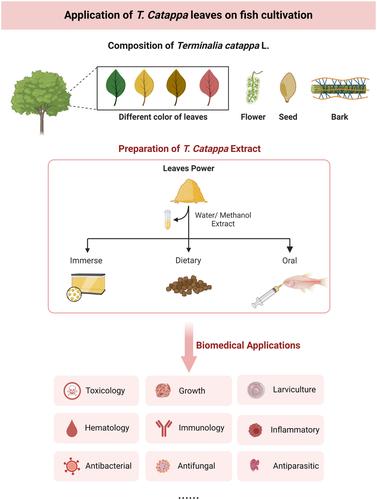当前位置:
X-MOL 学术
›
Rev. Aquacult.
›
论文详情
Our official English website, www.x-mol.net, welcomes your
feedback! (Note: you will need to create a separate account there.)
Recent advances of Terminalia catappa and its application in fish culture: A review
Reviews in Aquaculture ( IF 8.8 ) Pub Date : 2024-05-02 , DOI: 10.1111/raq.12920 Xu Wang 1 , Norhidayah Mohd Taufek 1, 2 , Norhafiza Mohd Arshad 3
Reviews in Aquaculture ( IF 8.8 ) Pub Date : 2024-05-02 , DOI: 10.1111/raq.12920 Xu Wang 1 , Norhidayah Mohd Taufek 1, 2 , Norhafiza Mohd Arshad 3
Affiliation

|
High-intensity aquaculture may cause the aquatic animals to experience elevated stress levels, which in turn will increase their susceptibility to illness and result in substantial losses. Farmers frequently use chemical and antibiotic treatments for fish diseases, which have led to drug-resistant and hazardous residues in farmed fish and the environment. Consequently, finding substitutes for chemicals and antibiotics is crucial for disease management in aquaculture. Terminalia catappa L. or commonly called Indian almond is well known for its medicinal properties and widely distributed in tropical and subtropical regions. T. catappa contains chemical compounds such as tannin and flavonoid that play an important role in antibacterial, anti-allergy, anti-inflammation, and anti-cancer. Numerous studies have been conducted on leaves, bark, fruits, and seed of T. catappa for their applications, including medicinal, bioremediation (dye absorption), and aquaculture use. Much research can be found on the utilization of T. catappa leaves to improve fish well-being, mostly in the ornamental fish industry. Extract of T. catappa has been found to improve fish survival, growth rate, inhibit bacterial infection, improve water quality, enhance fish colouration, and boost the immune response. Although T. catappa leaves have undergone substantial research, it has not been systematically described in connection to fish species used in aquaculture. This review will systematically discuss the biotoxicity of T. catappa evaluation of growth-promoting properties, eggs and larviculture performance, and enhancement of fish resistance to various bacteria, fungi, and parasites. In addition, the article also highlights the future perspectives of using T. catappa to improve fish culture.
中文翻译:

榄仁树及其在鱼类养殖中的应用研究进展
高强度的水产养殖可能会导致水产动物承受较高的应激水平,从而增加其患病的可能性并造成重大损失。农民经常使用化学和抗生素治疗鱼类疾病,这导致养殖鱼类和环境中出现耐药性和有害残留。因此,寻找化学品和抗生素的替代品对于水产养殖疾病管理至关重要。榄仁树(Terminalia catappa L.)或俗称印度杏仁以其药用特性而闻名,广泛分布于热带和亚热带地区。猫爪草含有单宁、类黄酮等化学成分,在抗菌、抗过敏、抗炎、抗癌等方面发挥着重要作用。人们对卡帕叶、树皮、果实和种子的应用进行了大量研究,包括药用、生物修复(染料吸收)和水产养殖用途。关于利用T. catappa叶改善鱼类福祉的研究很多,主要是在观赏鱼行业。研究发现,T. catappa提取物可以提高鱼类的存活率、生长速度、抑制细菌感染、改善水质、增强鱼类的色泽并增强免疫反应。尽管对T. catappa叶进行了大量研究,但尚未系统地描述其与水产养殖中使用的鱼类的关系。本综述将系统地讨论T. catappa的生物毒性,评估促生长特性、卵和幼体养殖性能,以及增强鱼类对各种细菌、真菌和寄生虫的抵抗力。 此外,文章还重点介绍了利用T. catappa改善鱼类养殖的未来前景。
更新日期:2024-05-02
中文翻译:

榄仁树及其在鱼类养殖中的应用研究进展
高强度的水产养殖可能会导致水产动物承受较高的应激水平,从而增加其患病的可能性并造成重大损失。农民经常使用化学和抗生素治疗鱼类疾病,这导致养殖鱼类和环境中出现耐药性和有害残留。因此,寻找化学品和抗生素的替代品对于水产养殖疾病管理至关重要。榄仁树(Terminalia catappa L.)或俗称印度杏仁以其药用特性而闻名,广泛分布于热带和亚热带地区。猫爪草含有单宁、类黄酮等化学成分,在抗菌、抗过敏、抗炎、抗癌等方面发挥着重要作用。人们对卡帕叶、树皮、果实和种子的应用进行了大量研究,包括药用、生物修复(染料吸收)和水产养殖用途。关于利用T. catappa叶改善鱼类福祉的研究很多,主要是在观赏鱼行业。研究发现,T. catappa提取物可以提高鱼类的存活率、生长速度、抑制细菌感染、改善水质、增强鱼类的色泽并增强免疫反应。尽管对T. catappa叶进行了大量研究,但尚未系统地描述其与水产养殖中使用的鱼类的关系。本综述将系统地讨论T. catappa的生物毒性,评估促生长特性、卵和幼体养殖性能,以及增强鱼类对各种细菌、真菌和寄生虫的抵抗力。 此外,文章还重点介绍了利用T. catappa改善鱼类养殖的未来前景。
















































 京公网安备 11010802027423号
京公网安备 11010802027423号